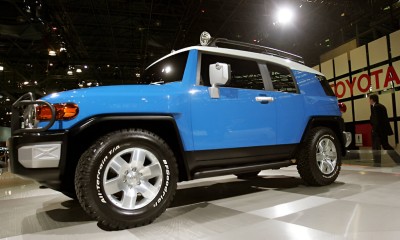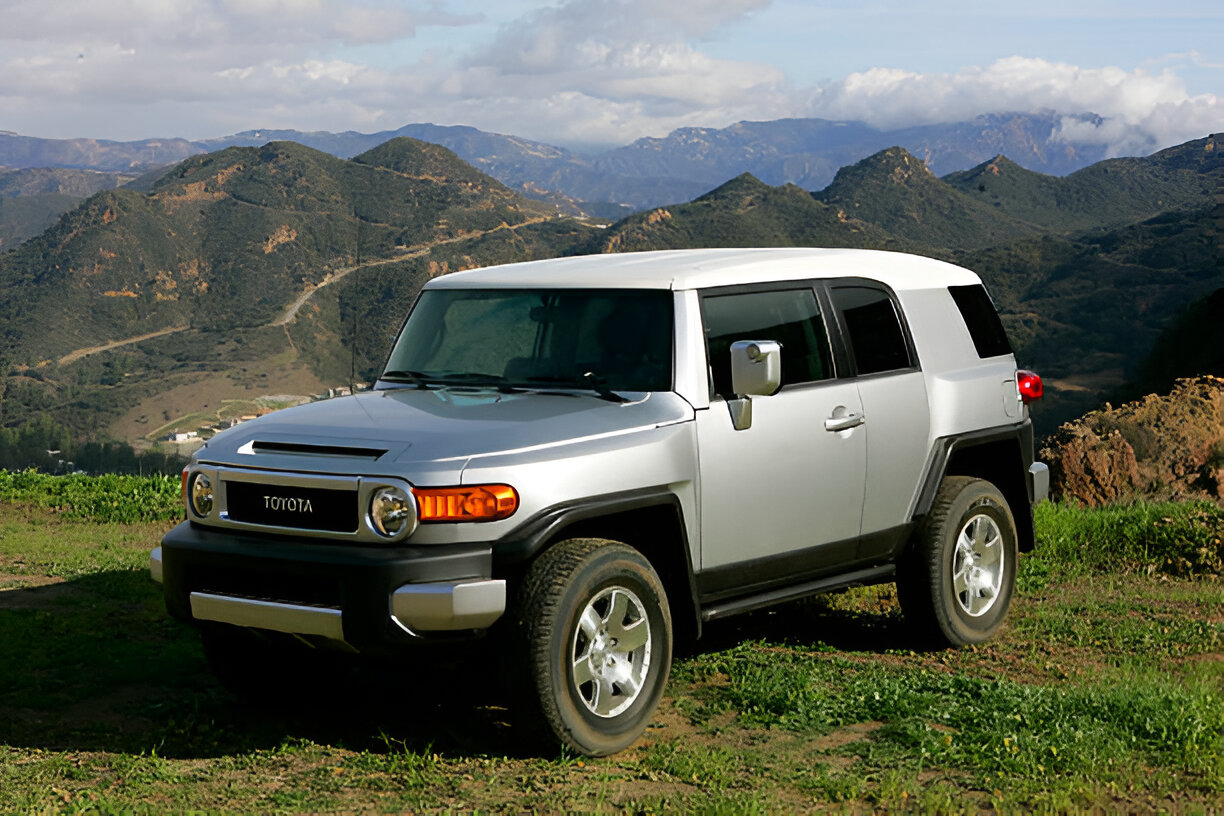Toyota FJ Cruiser 2025: The Legend's Return & Ultimate Tuning Guide

In the world of off-road vehicles, few names evoke the same level of passion and nostalgia as the Toyota FJ Cruiser. Since its departure from most global markets, a dedicated community of enthusiasts has kept the spirit of this modern classic alive, fueling a constant stream of speculation about its potential return. Recent years have seen this speculation intensify, with a flurry of patent filings, concept vehicles, and insider rumors suggesting that Toyota is preparing to reintroduce its iconic, retro-styled SUV to the world.
However, this excitement has been accompanied by significant market confusion. Much of the official news from Toyota has centered on the confirmed launch of the 2025 Toyota Land Cruiser (J250 series), a modernized, hybrid-powered vehicle that pays homage to its own storied lineage. While a landmark vehicle in its own right, it is not the direct successor to the FJ Cruiser that many are anticipating. This has created a complex information landscape where the lines between the confirmed Land Cruiser and the rumored FJ Cruiser are often blurred.
This report will serve as the definitive technical resource for the forthcoming FJ Cruiser. It will cut through the noise, synthesize the most credible engineering data, and analyze the most likely powertrain pathways Toyota will pursue. Most importantly, for the professional tuner and performance enthusiast, this document provides a detailed, expert-level roadmap for unlocking the vehicle's true potential through advanced Engine Control Unit (ECU) tuning.
Deconstructing the Rumors: What We Know About the 2025 FJ Cruiser
To understand the tuning potential of the new FJ Cruiser, one must first build a clear picture of the vehicle itself. By analyzing trademark filings, design patents, and strategic platform choices, we can construct a highly probable profile of this upcoming off-road contender.
The Name Game: FJ Cruiser or Land Cruiser FJ?
A significant indicator of Toyota's strategy lies in its intellectual property filings. The company has officially trademarked the name "Land Cruiser FJ," a move that suggests a deliberate rebranding effort. This naming convention would formally integrate the new vehicle into the prestigious Land Cruiser family, leveraging a nameplate synonymous with durability and off-road prowess for over 70 years.
This strategic positioning would likely place the Land Cruiser FJ as a more compact, rugged, and potentially more accessible alternative to the larger Land Cruiser J250. It would be aimed squarely at competitors like the Ford Bronco and Jeep Wrangler, catering to a market segment that values pure off-road capability and iconic design over the premium comforts of its larger sibling.
Design, Platform, and Off-Road Tech
Leaked patent images and official design teasers have provided a remarkably consistent vision of the new vehicle's aesthetics. The design is an evolution of the beloved original, featuring a boxy, utilitarian stance, thick C-pillars, a tailgate-mounted spare tire, and a front fascia with either classic round or modern rectangular LED headlights. It is expected to be a five-door model, addressing one of the practical limitations of the original's clamshell door design.
The engineering foundation of the vehicle—its platform—is the most critical factor, as it dictates everything from powertrain options to market positioning. Two primary theories have emerged based on industry analysis:
-
TNGA-F Platform: A modified version of Toyota's modern, body-on-frame global architecture. This platform underpins premium vehicles like the new Land Cruiser J250, Lexus GX, and Tundra. Its use would suggest a more refined, technologically advanced vehicle targeted at markets like North America, engineered to accommodate modern turbocharged and hybrid powertrains.
-
IMV-0 Platform: A more rugged, cost-effective ladder-frame platform developed for global markets, which is expected to be the basis for the next-generation HiLux and Fortuner. This platform is typically paired with robust, workhorse engines, including turbodiesels.
The choice between these two platforms is a powerful leading indicator of the vehicle's intended purpose and powertrain. A North American-focused Bronco competitor would almost certainly leverage the more sophisticated TNGA-F platform to house the 2.4L turbocharged engine family. Conversely, a globally-focused, utility-oriented vehicle would align perfectly with the IMV-0 platform and its associated diesel and simpler petrol engines. This strategic decision is the single most important variable in forecasting the new FJ Cruiser's tuning landscape.
Projected Release and Market Impact
While timelines remain fluid, the consensus points toward a global debut in late 2025, with vehicles arriving in dealerships for the 2026 model year. Pricing is anticipated to be highly competitive, positioning the FJ Cruiser between the 4Runner and the new Land Cruiser. Projections place the starting Manufacturer's Suggested Retail Price (MSRP) in the range of $45,000 to $55,000, making it a compelling option in the booming off-road SUV segment. 
Powertrain Analysis: A Tuner's Guide to the New FJ Cruiser's Heart
The performance potential of any vehicle is fundamentally defined by its engine. Based on Toyota's current global portfolio and the strategic platform choices outlined above, four distinct powertrains emerge as the most probable candidates for the new FJ Cruiser. Each presents a unique set of characteristics and a distinct pathway for performance enhancement through ECU tuning.
|
Engine |
Displacement |
Induction |
Stock Power (HP) |
Stock Torque (lb-ft) |
|
1GR-FE V6 |
4.0L |
Naturally Aspirated |
260 - 270 |
271 - 280 |
|
T24A-FTS I4 |
2.4L |
Turbocharged |
278 |
317 |
|
i-FORCE MAX Hybrid |
2.4L Turbo + E-Motor |
Turbocharged Hybrid |
326 (combined) |
465 (combined) |
|
1GD-FTV Diesel I4 |
2.8L |
Turbocharged |
175 - 201 |
332 - 369 |
The Legacy Option: 4.0L 1GR-FE V6
The 1GR-FE is a legendary engine in Toyota's lineup, a 4.0-liter, 24-valve DOHC V6 renowned for its robust construction and exceptional reliability. It powered the original FJ Cruiser, as well as generations of the Tacoma, 4Runner, and Land Cruiser Prado. Later versions of this engine feature Dual VVT-i (Variable Valve Timing with intelligence) on both intake and exhaust camshafts, producing up to 270 horsepower and 280 lb-ft of torque.
From a tuning perspective, the 1GR-FE is a known and trusted quantity. As a naturally aspirated engine, its performance is predictable. While it responds well to calibration changes that optimize ignition timing and fuel maps for higher-octane fuel, significant power gains require the addition of forced induction hardware. Its inclusion in the new FJ Cruiser would represent a nod to tradition and reliability, offering a solid but conventional tuning foundation.
The Likely Successor: 2.4L T24A-FTS Turbo
The T24A-FTS turbocharged inline-four is Toyota's modern powertrain solution for its body-on-frame vehicles, currently serving as the core engine for the new-generation Tacoma and the non-hybrid Land Cruiser J250. This engine features advanced technologies like direct and port fuel injection and produces a stout 278 horsepower and 317 lb-ft of torque, with peak torque arriving at a low 1,700 RPM.
The introduction of this engine represents a fundamental paradigm shift for the Toyota tuning community. For decades, Toyota's trucks and SUVs have relied on naturally aspirated engines where performance gains from ECU tuning were modest. The T24A-FTS, with its factory-installed turbocharger, changes this dynamic entirely. The engine's output is no longer primarily limited by displacement, but by the ECU's control over boost pressure. This makes a professional ECU remap the single most effective and cost-efficient performance modification available. By recalibrating the ECU's boost, fuel, and ignition timing maps, tuners can unlock substantial power and torque gains without a single hardware change, making the core product of a tuning file provider more valuable and impactful than ever before on this new platform.
The High-Torque Hybrid: i-FORCE MAX
The i-FORCE MAX powertrain takes the potent T24A-FTS engine and integrates it with a 48-hp electric motor sandwiched between the engine and transmission. This hybrid system delivers a massive combined output of 326 horsepower and an astounding 465 lb-ft of torque. The electric motor provides instantaneous torque fill at low RPMs, eliminating turbo lag and creating a seamless, powerful wave of acceleration.
Tuning the i-FORCE MAX presents a sophisticated challenge that requires deep expertise. A successful calibration must not only optimize the parameters of the internal combustion engine but also manage the complex interplay between the turbocharger, electric motor, and battery management system. A simple increase in boost pressure is insufficient; the tune must ensure that the power delivery from both sources is perfectly harmonized across the entire rev range. This complexity elevates hybrid tuning to a specialist service, where the quality and reliability of the calibration file are paramount.
The Global Workhorse: 2.8L 1GD-FTV Turbodiesel
For markets outside of North America, the 2.8L 1GD-FTV turbodiesel is a highly probable candidate, especially if the new FJ Cruiser is based on the IMV-0 platform. This engine is a staple in the global HiLux, Fortuner, and Land Cruiser Prado. It exists in two primary states of tune: an earlier version producing around 177 hp and 332 lb-ft of torque (450 Nm), and an updated post-facelift version making a more robust 201 hp and 369 lb-ft of torque (500 Nm).
Known for its prodigious low-end torque, the 1GD-FTV is an ideal powertrain for heavy-duty applications like towing and technical off-roading. It is also exceptionally receptive to ECU tuning, with significant torque gains achievable through recalibration of fuel pressure, injection timing, and boost control.
Unlocking Hidden Performance: A Deep Dive into FJ Cruiser ECU Tuning
The Engine Control Unit is the brain of a modern vehicle, managing dozens of parameters to balance performance, emissions, and fuel economy. From the factory, these parameters are set with broad tolerances to account for varying fuel quality, climates, and operating conditions. ECU tuning, or remapping, is the professional process of optimizing this factory software to unlock the engine's true performance potential within safe mechanical limits.
What is ECU Tuning?
ECU tuning involves reading the original map file from the vehicle's ECU, modifying key parameters such as fuel injection volume, ignition timing, variable valve timing angles, and turbocharger boost pressure, and then writing the modified file back to the ECU. This process, when performed by experts using dyno-tested files, results in significant gains in horsepower and torque, improved throttle response, and a more engaging driving experience.
The table below outlines the projected performance gains for each potential FJ Cruiser powertrain using professional, dyno-tested tuning files from HP Chiptuningfiles.
|
Engine |
Stock (HP / lb-ft) |
Stage 1 (ECU Tune) |
Stage 2 (Tune + Intake/Exhaust) |
|
1GR-FE V6 |
270 / 278 |
~296 / 297 |
~315 / 319 |
|
T24A-FTS I4 |
278 / 317 |
~320 / 360 |
~340 / 380+ |
|
i-FORCE MAX |
326 / 465 |
~360 / 520 |
~375 / 540+ |
|
1GD-FTV Diesel |
201 / 369 |
~225 / 490 |
~245 / 550+ |
Naturally Aspirated Gains: Tuning the 1GR-FE
For the naturally aspirated 4.0L V6, a Stage 1 ECU tune focuses on refining the engine's existing capabilities. By optimizing the VVT-i camshaft phasing, advancing ignition timing, and adjusting fuel maps to take advantage of higher-octane fuel (91-93 octane / 95-98 RON), tangible improvements can be made. Dyno testing on similar platforms like the 4Runner shows that a quality Stage 1 remap can yield gains of approximately 25-30 horsepower and 20-30 lb-ft of torque. While these numbers are modest compared to forced-induction engines, the most noticeable benefit is the dramatic improvement in throttle response and mid-range torque, making the vehicle feel more responsive and eager during daily driving.
The Turbo Advantage: Remapping the T24A-FTS
The 2.4L turbocharged T24A-FTS engine is where ECU remapping delivers transformative results. The primary source of power gains comes from the precise and safe management of turbocharger boost pressure. By carefully increasing boost levels across the RPM range and recalibrating fuel and timing maps to support it, tuners can unlock a significant amount of power. Independent dyno tests have shown gains of 26 to 55 wheel horsepower from a software tune alone. Even more importantly, the tune can deliver a massive increase in low-end and mid-range torque, which completely changes the vehicle's driving dynamics, making it feel more powerful and effortless.
It is crucial to distinguish between a native ECU flash and a piggyback tuning box. Piggyback devices work by intercepting and altering sensor signals to "trick" the factory ECU into making changes. In contrast, a native ECU flash—the method used by HP Chiptuningfiles—directly rewrites the underlying code on the ECU itself. This provides a far more comprehensive, stable, and safer tuning solution, allowing for the adjustment of hundreds of parameters for seamless, factory-like integration.
Calibrating the i-FORCE MAX Hybrid
Tuning the i-FORCE MAX hybrid system offers the potential for the most dramatic torque gains. Early tuning development on this platform has demonstrated increases of nearly 90 lb-ft of torque at the wheels. Achieving these results safely requires a highly sophisticated calibration file. The tuner must have a deep understanding of the hybrid control module and how it orchestrates power flow from the engine and electric motor. A professional tune ensures this complex system works in harmony, delivering a massive, smooth, and reliable increase in performance.
Diesel Tuning Stages for the 1GD-FTV
Diesel engines are renowned for their response to tuning, and the 2.8L 1GD-FTV is no exception. The tuning pathway for this engine is typically broken into stages:
-
Stage 1: This involves a pure ECU remap on an otherwise stock vehicle. The focus is on increasing torque for improved towing and drivability. Typical gains are in the range of 20-25 kW (27-34 hp) and, most impressively, 100-120 Nm (74-89 lb-ft) of torque.
-
Stage 2: This combines a more aggressive ECU tune with supporting hardware modifications, such as a high-flow, larger-diameter exhaust system and an upgraded front-mount intercooler. These modifications reduce exhaust backpressure and lower intake air temperatures, allowing the tuner to safely increase fueling and boost to achieve even greater power levels.
-
Transmission (TCU) Tuning: A critical and often overlooked aspect of diesel tuning is recalibrating the Transmission Control Unit (TCU). The significant increase in torque from an ECU remap can overwhelm the stock transmission logic, leading to sluggish shifts or clutch pack slippage. A corresponding TCU tune adjusts shift points, increases clutch clamping pressure, and refines torque converter lock-up strategy to handle the extra power smoothly and reliably. This is a hallmark of a truly professional tuning package.
Advanced Performance Pathways: Supercharging and Beyond
For enthusiasts seeking the ultimate level of performance, particularly for the naturally aspirated 1GR-FE V6, forced induction via supercharging is the definitive answer. This hardware upgrade, paired with a precision ECU calibration, can elevate the FJ Cruiser into a true high-performance vehicle.
Case Study: Supercharging the 4.0L 1GR-FE V6
The 1GR-FE engine has a robust aftermarket for supercharger systems, thanks to its strong internal components. The leading kits on the market utilize different supercharger technologies:
-
Magnuson (Roots-Type): These kits, like the TVS1320, are known for delivering instantaneous, V8-like torque right off idle. They typically produce around 6-7 psi of boost and can increase the engine's output to over 335 hp and 345 lb-ft of torque.
-
Rotrex/URD (Centrifugal): These superchargers behave more like a belt-driven turbo, building boost progressively with engine RPM. They excel at producing strong top-end power and can support very high horsepower levels, with some kits capable of pushing the 1GR-FE to 400 hp and beyond.
-
URD/Whipple (Twin-Screw): Similar to a roots-type, twin-screw superchargers are positive displacement pumps that offer excellent low-end torque but are often more efficient at higher boost levels.
The Critical Role of the ECU Tune in Forced Induction
Installing a supercharger is a significant mechanical undertaking, but the hardware is only half of the equation. The ECU tune is the indispensable brain that makes the entire system function safely and effectively. A supercharger forces a much greater volume of air into the engine than its designers ever intended. The stock ECU calibration has no reference for this increased airflow and cannot provide the corresponding increase in fuel or adjust ignition timing to prevent detonation (engine knock).
Attempting to run a supercharged engine on a stock tune will result in a dangerously lean air-fuel ratio, leading to extreme combustion temperatures and, inevitably, catastrophic engine failure. A custom ECU tune is not an optional add-on for a supercharger kit; it is a mandatory, critical component.
While many supercharger kits are supplied with a basic handheld programmer that contains a generic, "canned" tune, these are designed to be a one-size-fits-all solution. For optimal performance, reliability, and safety, a custom file developed on a dynamometer by a specialist provider like HP Chiptuningfiles is the superior choice. A custom tune can be tailored to the specific vehicle, its modifications, local fuel quality, and the owner's performance goals, ensuring the entire system operates in perfect harmony.
The HP Chiptuningfiles Advantage: Precision, Reliability, and B2B Support
For tuning professionals and workshops, the quality and reliability of the files they use are paramount. HP Chiptuningfiles provides a comprehensive, professional-grade service designed to empower our B2B partners and ensure exceptional results for their customers.
Why Choose Our Dyno-Tested Tuning Files?
Our reputation is built on a foundation of meticulous quality control. Every tuning file we develop is engineered and rigorously tested on our in-house dynamometer. This process guarantees that our calibrations deliver real, verifiable performance gains while operating safely within the mechanical tolerances of the engine and drivetrain components. With access to our extensive (https://hp-chiptuningfiles.com/tuning-file-database), our partners can service a vast range of vehicles with confidence, knowing each file meets our exacting standards.
A Partnership for Professionals
We have streamlined the process for workshops and dealers to integrate our services into their business. The pathway to becoming a partner is straightforward:
-
Create a Free Account on our B2B portal to gain access to our platform and file service.
-
Purchase Credits at competitive B2B pricing tiers, allowing for excellent profit margins.
-
Select the necessary (https://hp-chiptuningfiles.com/hardware), including master and slave tools from leading manufacturers.
-
Upload your customer's original ECU file through our portal, and our team of engineers will promptly return a custom-modified tuning file tailored to your specifications.
Unmatched Support
We understand that professional tuners require more than just quality files; they need reliable support. Our team of experienced engineers is available to assist our dealer network with technical questions and file support, ensuring you can complete every job efficiently and effectively. For any inquiries, our support team is readily accessible through our Contact Us page.
Frequently Asked Questions (FAQ)
Is ECU tuning safe for the new FJ Cruiser's engine?
Yes. Professional ECU tuning is a safe and reliable method for enhancing performance. Our custom tuning files are developed to operate within the safe mechanical limits of the engine and its components. Critically, all factory safety systems, such as knock detection, temperature monitoring, and overboost protection, are retained and fully functional, ensuring long-term reliability.
Will I need to upgrade any hardware for a Stage 1 tune?
For a Stage 1 ECU remap, no hardware upgrades are necessary. The tune is designed to optimize the performance of the stock engine. However, to achieve the advertised gains and ensure optimal combustion, we strongly recommend using high-quality, premium fuel (91 octane / 95 RON or higher). For Stage 2 and more advanced tuning, hardware upgrades like high-flow intakes, performance exhausts, and upgraded intercoolers are required.
Can the i-FORCE MAX hybrid powertrain be tuned effectively?
Absolutely. The i-FORCE MAX hybrid system is highly responsive to tuning, capable of producing significant gains in torque across the powerband. Due to its complexity, it requires an expert-level calibration file that can precisely manage the intricate relationship between the gasoline engine, turbocharger, and electric motor to ensure smooth, powerful, and reliable operation.
How do I become an HP Chiptuningfiles dealer?
Becoming an official HP Chiptuningfiles dealer is a simple process designed for tuning professionals. Visit our (https://hp-chiptuningfiles.com/b2b) to register for a free account. Once your account is approved, you can purchase tuning credits, browse our hardware offerings, and gain access to our complete database of over 80,000 custom, dyno-tested tuning files.
Conclusion: Unleash Your FJ Cruiser's True Potential
The impending return of the Toyota FJ Cruiser marks an exciting new chapter for one of the most beloved off-road platforms in recent history. The speculation surrounding its final form—from its name and design to its underlying platform—is matched only by the anticipation for its performance capabilities. Whether it arrives with the legendary 1GR-FE V6, the modern T24A-FTS turbo, the torque-rich i-FORCE MAX hybrid, or the robust 1GD-FTV diesel, one fact remains constant: the key to unlocking its ultimate performance lies within the code of its Engine Control Unit.
Professional ECU remapping transforms a vehicle from its factory-compromised state into a finely tuned machine, optimized for power, responsiveness, and drivability. For the professional tuning workshop, the new FJ Cruiser represents a significant business opportunity. Being prepared with the highest quality files and the best support is essential for capitalizing on the next generation of Toyota performance.
Ready to prepare your workshop for the future of Toyota tuning? Create your professional account today and explore the power of HP Chiptuningfiles.
Other news and updates

Read more OBD Breakthrough: Tuning Support for the Continental ASG1 ECU in Audi e-tron & Porsche Taycan
The Continental ASG1 ECU used in the Audi e-tron and Porsche Taycan is now fully supported for OBD read/write. This breakthrough allows safe tuning of torque limits, current maps, thermal strategies and pedal response, enabling measurable performance gains whi...
Read more

Read more Stage 1, Stage 2, and Stage 3 Tuning: Which One Is Right for You? | HP Chiptuning Files Europe & UK
Discover the differences between Stage 1, Stage 2, and Stage 3 tuning. Learn which remap is best for your car, driving style, and budget at hp-chiptuningfiles.com.
Read more

Read more Mercedes-AMG G63 2025: ECU Remap & Performance Boost
Hey, we are HP Chiptuningfiles – Europe’s leading ECU tuning file service provider. We deliver custom, dyno-tested tuning files for diesel, petrol & hybrid engines, trusted by 4,000+ clients worldwide. The 2025 Mercedes-AMG G63 combines iconic G-Class ruggedne...
Read more